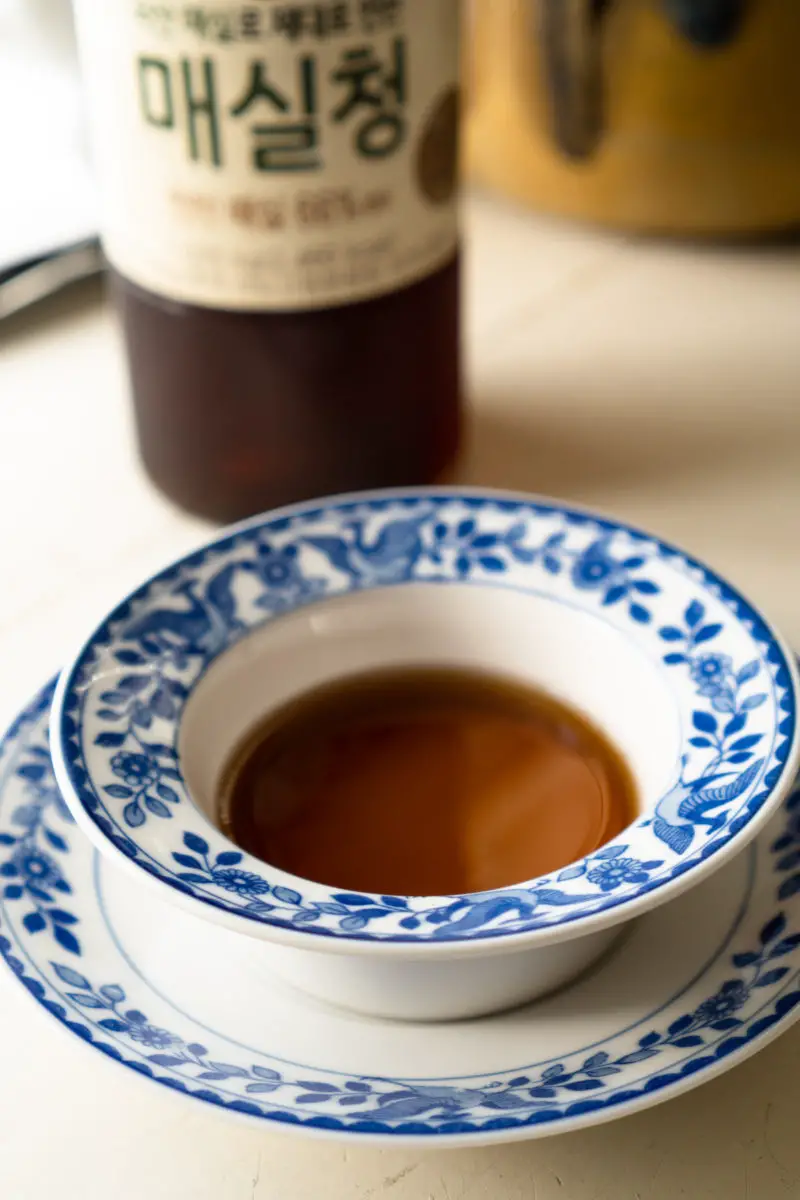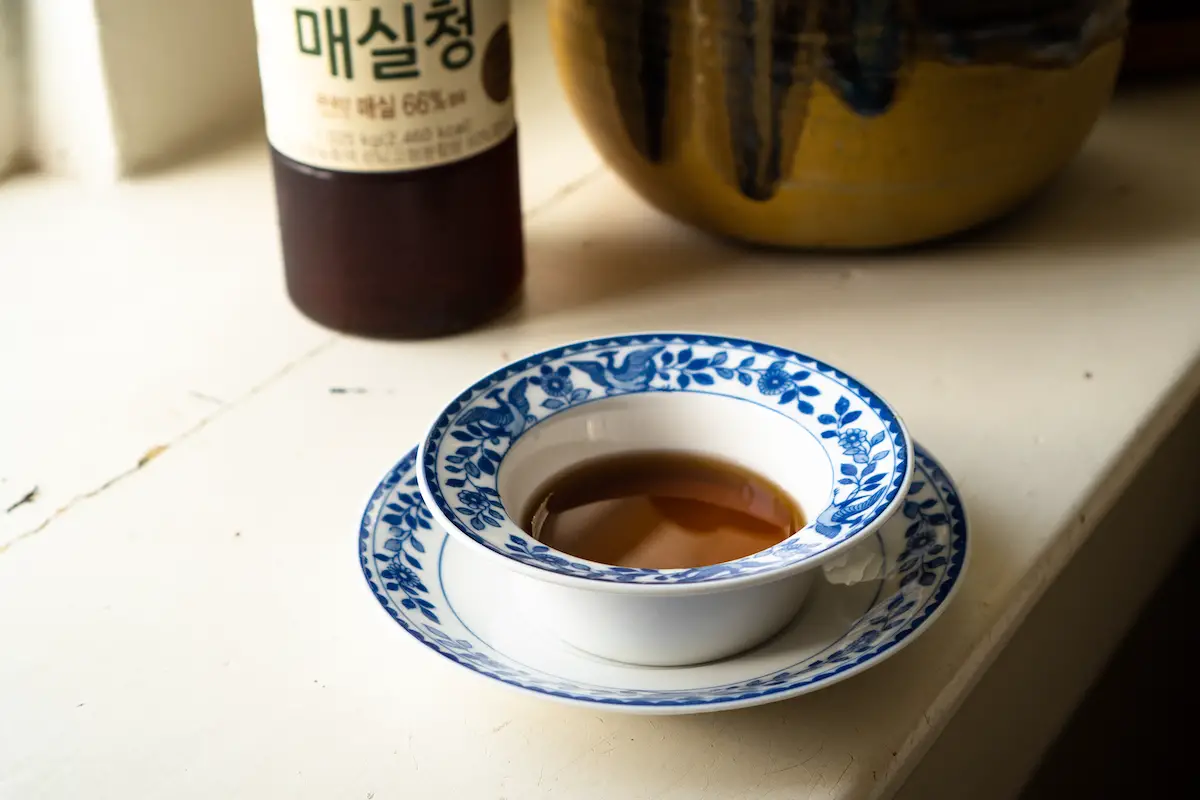This post may contain affiliate links. Please read my disclosure for details at the bottom of this page. As an Amazon Associate, I earn from qualifying purchases on this article about maesil cheong, otherwise known as Korean green plum extract. I hope you enjoy learning about Korean green plum syrup!
Published 09/06/2022 Updated 06/26/2025
In South Korea, people use different types of sweeteners beyond sugar to add depth of flavor to dishes. Such sweeteners can include rice syrup, fresh Asian pears, corn syrup, mirim, malt syrup, honey, and more!
In this article, I will teach you about Korean green plum extract, known as ‘maesil cheong.’ Let’s get started!
What Is Maesil Cheong (Green Plum Syrup)?
Maesil cheong, otherwise known as maesil syrup, Korean green plum extract, or green plum syrup, is a Korean sweetener used regularly when cooking.
In South Korea, people traditionally make maesil cheong by combining fresh green plums with sugar in a sterilized container. As the green plums break down, ferment, and combine with the sugar, it turns into a sweet fruity syrup. The full process takes approximately 100 days. After those 100 days, the plums can be removed. Then, people consume the syrup right away or let it continue to sit and mature.
Home cooks use this anti-microbial syrup as a condiment and sugar substitute.
Maesil Cheong vs Maesil Wonaek:
You may see both ‘maesil cheong’ (매실청) and ‘maesil wonaek’ (매실원액) when shopping for green plum syrup. Both are very similar ingredients often used in Korean cooking. When I asked my husband about the difference, he stated home cooks typically use these ingredients interchangeably.
Through further research, I found that in some instances, products labeled as ‘Maesil cheong’ (매실청) or ‘maesil wonaek’ (매실원액) are the same. In other instances they differ in the amount of sugar used, affecting the sweetness and viscosity.
Green Plum Extract in Korean Cuisine:
As stated above, in South Korea, people refer to green plum extract or syrup as ‘maesil cheong’ (매실청). The term ‘maesil’ (매실) translates to ‘green plum.’ The term ‘cheong’ (청) refers to a honey-like syrup made from fruits ana grains. Below, we list a few well-known dishes that often include this sweetener ingredient:
- Minari Muchim (미나리무침): In English, this translates to Korean watercress salad. In m recipe, I use Korean green plum extract as a sweetening ingredient.
- Maesil-Cha (매실차): This traditional Korean tea is made from fresh green plums or maesil cheong. People drink this Korean green plum tea either hot or cold throughout the year.
- Baechu Geotjeori (배추겉절이): In English, people translate this dish as ‘fresh kimchi.’ You make this dish right before consuming it, unlike regular kimchi. People often include a sweetener such as maesil cheong in this light and refreshing cabbage dish.
In the end, people use this ingredient in any or all dishes that require a sweetener. It depends on the person cooking and the recipe they are following. You can always experiment with different Korean sweeteners when cooking at home!
Note: To learn more about green plums in Korean cooking, read my article titled ‘Green Plums in Korean Cooking (Maesil),’ on the subject!

Maesil Cheong Frequently Asked Questions:
Now that we learned about maesil cheong in Korean cuisine, we want to answer some questions you may have about this ingredient! If we do not answer your question, feel free to leave a comment in the section below or email us at [email protected].
What Does Korean Green Plum Extract Taste Like?
As expected, Korean green plum syrup tastes sweet and fruity. You can also taste hints of acidity from the fermented plums.
Where Can I Buy It?
I recommend visiting your local Asian grocery store when shopping for maesil cheong. You can also find this Korean green plum extract online!
Where to Buy Korean Ingredients Online?
Nowadays, there are many online options to choose from to order Korean food online. These websites are not limited to but include:
- Amazon
- H-mart
- Hanpoom
- Wooltari
How Do I Properly Store This Ingredient?
Before opening, you can keep maesil cheong in a cool, dark place like your pantry. Once opened, follow the instructions on the bottle. Most state that the product should be refrigerated.
What Is a Good Maesil Cheong Substitute?
If you cannot find maesil cheong, you can combine water, apple cider vinegar, and sugar. This substitute mimics the tangy and sweet flavor. Unfortunately, it doesn’t taste the same, but will work until you can find or make the real deal!
You can use other types of syrups, sugar, or honey as well. Just note, the dish won’t have those fruity notes.
I Hope You Enjoyed Learning About Maesil Cheong!
In the end, I hope you enjoyed learning about the maesil cheong, otherwise known as Korean green plum extract or Korean green plum syrup! If so, let me know in the comment section!
If you would like to read more about cooking, you can find recipes as well as further Korean ingredient articles on our blog. I listed some of our favorite Carving A Journey Korean recipes below! For reference, many recipes are influenced by my family’s blended Korean and Southern heritage.
Korean Ingredient Articles:
- Baechu (Napa Cabbage) in Korean Cuisine
- What are Perilla Leaves (Kkaennip)?
- Gochugaru (Korean Pepper Powder)
- Gluten-Free Gochujang Brands
- Gluten-free Doenjang Brands
Further Carving A Journey Recipes:
- Korean Sweet Potato Latte (Goguma Latte)
- Greek Momo Recipe (Korean Breakfast Trend)
- Tteokkochi (Korean Rice Cake Skewers)
- Jumeokbap (Handmade Korean Rice Balls)
If you have any questions or comments, you can also email me at [email protected].
And, finally, I would love to hear from you through social media as well! You can follow me at @carvingajourney on Instagram, Facebook, and Pinterest. Or, if you would like more articles like these, you can subscribe to my blog by joining the mailing list. Let me know if you try cooking with maesil cheong! Thank you so much for stopping by!
Carving A Journey is a participant in the Amazon Services LLC Associates Program, an affiliate advertising program designed to provide a means for sites to earn advertising fees by advertising and linking to Amazon.com. Although we may earn commissions for our endorsement, recommendation, testimonial, and/or link to any products or services from this website, these opinions are my own and I fully support these products.

